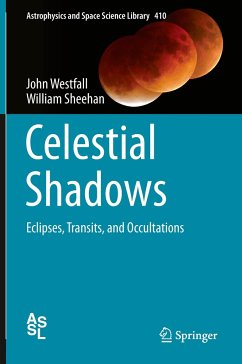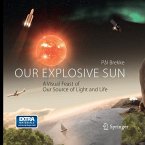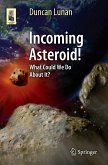Much of what is known about the universe came from the study of celestial shadows. This book looks in detail at the way eclipses and other celestial shadows have given us amazing insights into the nature of the objects in our solar system and how they are even helping us discover and analyze planets that orbit stars other than our Sun. A variety of eclipses, transits, and occultations of the mooons of Jupiter and Saturn, Pluto and its satellite Charon, asteroids and stars have helped astronomers to work out their dimensions, structures, and shapes - even the existence of atmospheres and structures of exoplanets.
Long before Columbus set out to reach the Far East by sailing West, the curved shadow of the Earth on the Moon during a lunar eclipse revealed that we inhabit a round world, a globe. More recently, comparisons of the sunlit and Earthlit parts of the Moon have been used to determine changes in the Earth's brightness as a way of monitoring possible effects in cloud coverage which may be related to global warming. Shadows were used by the Greek mathematician Eratosthenes to work out the first estimate of the circumference of the Earth, by Galileo to measure the heights of the lunar mountains and by eighteenth century astronomers to determine the scale of the Solar System itself.
Some of the rarest and most wonderful shadows of all are those cast onto Earth by the lovely "Evening Star" Venus as it goes between the Earth and the Sun. These majestic transits
of Venus occur at most two in a century; after the 2012 transit, there is not a chance to observe this phenomenon until 2117, while the more common sweep of a total solar eclipse creates one of the most dramatic and awe-inspiring events of nature. Though it may have once been a source of consternation or dread, solar eclipses now lead thousands of amateur astronomers and "eclipse-chasers" to travel the globe in order to experience the dramatic view under "totality." These phenomena are among the most spectacular available to observers and are given their full due in Westfall and Sheehan's comprehensive study.
Long before Columbus set out to reach the Far East by sailing West, the curved shadow of the Earth on the Moon during a lunar eclipse revealed that we inhabit a round world, a globe. More recently, comparisons of the sunlit and Earthlit parts of the Moon have been used to determine changes in the Earth's brightness as a way of monitoring possible effects in cloud coverage which may be related to global warming. Shadows were used by the Greek mathematician Eratosthenes to work out the first estimate of the circumference of the Earth, by Galileo to measure the heights of the lunar mountains and by eighteenth century astronomers to determine the scale of the Solar System itself.
Some of the rarest and most wonderful shadows of all are those cast onto Earth by the lovely "Evening Star" Venus as it goes between the Earth and the Sun. These majestic transits
of Venus occur at most two in a century; after the 2012 transit, there is not a chance to observe this phenomenon until 2117, while the more common sweep of a total solar eclipse creates one of the most dramatic and awe-inspiring events of nature. Though it may have once been a source of consternation or dread, solar eclipses now lead thousands of amateur astronomers and "eclipse-chasers" to travel the globe in order to experience the dramatic view under "totality." These phenomena are among the most spectacular available to observers and are given their full due in Westfall and Sheehan's comprehensive study.
Selected by Choice magazine as an "Outstanding Academic Title" for 2015
"In Celestial Shadows, westfall ... summarize all the ways in which observational astronomers and planetary scientists use eclipses, transits, and occultations to study distant objects. ... This 22-chapter book collects in one place such a tremendous amount of information that it will be very useful, in particular, to those who wish to learn about how these events have previously allowed and continue to allow scientists to study solar system objects in unique ways. ... Summing Up: Highly recommended. All levels/libraries." (C. Palma, Choice, Vol. 52 (10), June, 2015)
"The authors explain the astronomy, how to make observations, flag up future events, and link them to a rich history in which such observations contributed to significant developments in astronomy. ... this work is as good a place as any for amateur astronomers to begin engagement with a history that takes them beyond the usual accounts of heroes and moments of discovery and makes a useful resource for historians and educators." (Rebekah Higgitt, Journal for the History of Astronomy, Vol. 47 (4), November, 2016)
"In Celestial Shadows, westfall ... summarize all the ways in which observational astronomers and planetary scientists use eclipses, transits, and occultations to study distant objects. ... This 22-chapter book collects in one place such a tremendous amount of information that it will be very useful, in particular, to those who wish to learn about how these events have previously allowed and continue to allow scientists to study solar system objects in unique ways. ... Summing Up: Highly recommended. All levels/libraries." (C. Palma, Choice, Vol. 52 (10), June, 2015)
"The authors explain the astronomy, how to make observations, flag up future events, and link them to a rich history in which such observations contributed to significant developments in astronomy. ... this work is as good a place as any for amateur astronomers to begin engagement with a history that takes them beyond the usual accounts of heroes and moments of discovery and makes a useful resource for historians and educators." (Rebekah Higgitt, Journal for the History of Astronomy, Vol. 47 (4), November, 2016)








